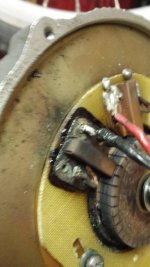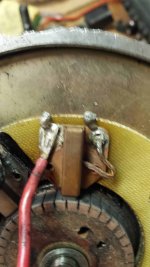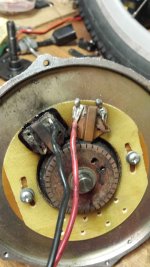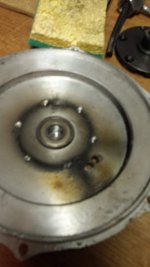markz
100 TW
I was going to place this in my original thread, then decided its better suited on its own. Luckily I saved all my pics to desktop. Plus copied the text.
I heated this puppy up, after a 30km ride. It wasnt really smoking, just very hot motor.
It took awhile for my first openening of any hub. I took it slow.
So this ride I was on was coming to an end, last small hill before the home stretch. After the motor stopped I hoofed it up 30' to the grass at the top of the hill and touched the motor, it was hot to the touch. I couldnt hold my hand on the hub for longer then 2 or 3 seconds. Newbie mistake on my part, I knew better not to stall it on the hill.
Here are some pictures. Now I have no idea what to do, where to buy parts, nothing. I kind of want to keep this motor, I like it. Its a little loud, people can hear me come up from behind unlike my DD mxus 4506 v2.
This motor originally had 36V lead acid batteries attached to it. I took it up to 49.8V (hoc) RC Lipo, I could get it up to 30km/h, kept up with playground zone traffic easily.




View attachment 3
View attachment 2
The motor manually spins good, gears look good. Wires, not so good.
Where do the bare wires go, corresponding to red/black. I think solder back on the bare wire on black side. Its a brushed motor I believe, I had a pic somewhere of the controller clueing into something.
Found it.
View attachment 1
Notice how it says DC Brushes. So its brushed, got "brushes", thats probably where either bare or colored wires go. Be nice to swap out brushes, probably a technical adventure.
edit:
My next step is to open it up even more. Undo those 2 screws slowly and see whats next. Maybe the commutator and brushes etc.
Amazingly this thing is stinking up my house, I bagged it and its sitting outside. Smells like burnt insulation, with a tad bit of oily substance to it. There was grease in the thing.
The magnets look burnt, hope they are alright.
I got this pic here.
I heated this puppy up, after a 30km ride. It wasnt really smoking, just very hot motor.
It took awhile for my first openening of any hub. I took it slow.
So this ride I was on was coming to an end, last small hill before the home stretch. After the motor stopped I hoofed it up 30' to the grass at the top of the hill and touched the motor, it was hot to the touch. I couldnt hold my hand on the hub for longer then 2 or 3 seconds. Newbie mistake on my part, I knew better not to stall it on the hill.
Here are some pictures. Now I have no idea what to do, where to buy parts, nothing. I kind of want to keep this motor, I like it. Its a little loud, people can hear me come up from behind unlike my DD mxus 4506 v2.
This motor originally had 36V lead acid batteries attached to it. I took it up to 49.8V (hoc) RC Lipo, I could get it up to 30km/h, kept up with playground zone traffic easily.




View attachment 3
View attachment 2
The motor manually spins good, gears look good. Wires, not so good.
Where do the bare wires go, corresponding to red/black. I think solder back on the bare wire on black side. Its a brushed motor I believe, I had a pic somewhere of the controller clueing into something.
Found it.
View attachment 1
Notice how it says DC Brushes. So its brushed, got "brushes", thats probably where either bare or colored wires go. Be nice to swap out brushes, probably a technical adventure.
edit:
My next step is to open it up even more. Undo those 2 screws slowly and see whats next. Maybe the commutator and brushes etc.
Amazingly this thing is stinking up my house, I bagged it and its sitting outside. Smells like burnt insulation, with a tad bit of oily substance to it. There was grease in the thing.
The magnets look burnt, hope they are alright.
I got this pic here.

